This announcement feels a bit like a “finally.” The Dell EMC PowerEdge XE7100 is a 100-bay top-loading storage server. In the world of storage, top-loading storage has become extremely popular for applications such as scale-out, video, and object storage. Dell is taking lessons learned with its DSS 7000 series and is launching a new storage server line to address these types of applications while doing things a bit differently.
Dell EMC PowerEdge XE7100
Perhaps one of the most notable differences with the Dell EMC PowerEdge XE7100 is that it is a 5U design instead of the common 4U design in the industry. As a result, Dell shrinks the server depth to 911mm or about 35.9 inches. In the world of top-loading systems, that is important for many customers as a ~36-inch server will fit in most standard racks. Many top-loading systems require specialized racks for depth and weight. We are going to address weight later.
“Industry’s highest storage density 5U server” is Hard to Justify
Before we get into that, we want to address a very borderline claim Dell EMC is making with the announcement. You can see this below:
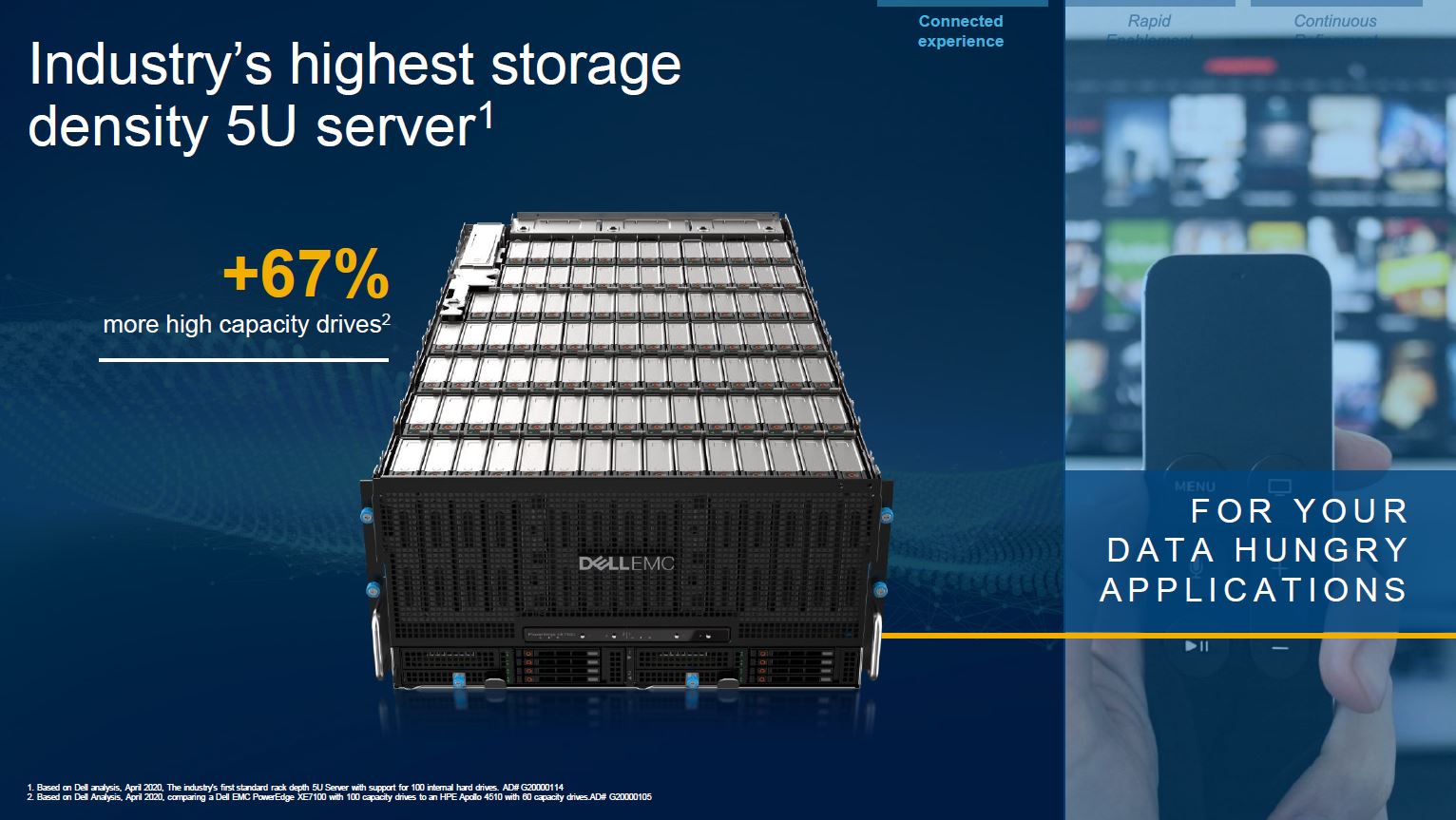
We are going to take a moment to call out Dell’s marketing here. When they are saying “Industry’s highest storage density 5U server” Dell is, in its footnote, comparing to the HPE Apollo 4510 with 60 drives. The Apollo 4510 is a 4U 60-bay system for 15 drives per U. That is also about equivalent to the Supermicro 60-Bay Top Loading Storage Server. STH was the first to do hands-on profiling of the new for 2020 Supermicro 60-bay option with the 90-bay Supermicro version being released as well. While we looked at the 60-bay version, the 90-bay version is simply deeper with more drives. With 90 bays in 4U, we get 22.5 drives per U which are 12.5% denser than Dell’s new XE7100.
We looked at the Inspur 106-bay storage server in 2018 which we noted at the time was just a bit larger than other solutions. That Inspur solution offers 26.5 drives per U or 32.5% better storage density than Dell.
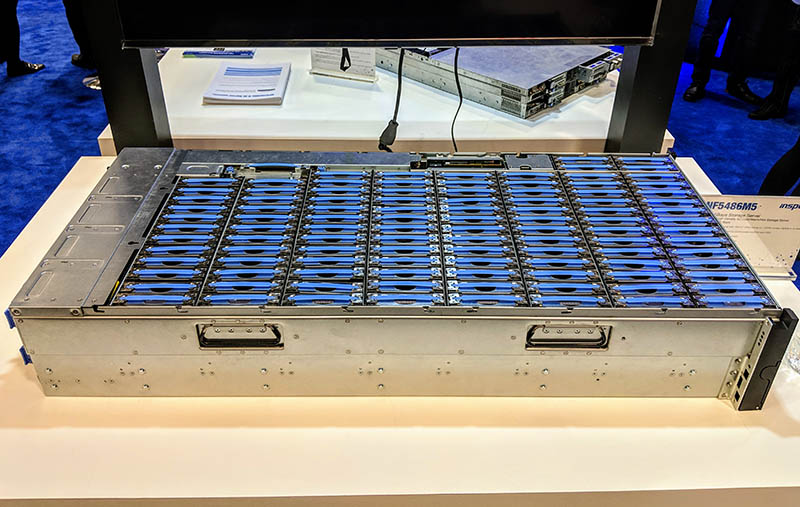
Breaking down the “Industry’s highest storage density 5U server” claim it is only accurate if one limits their discussion to 5U servers specifically. In this market, putting as many drives per U of storage is often the most important metric. For density measured in drives/ U PowerEdge XE7100 is nowhere near a “highest storage density” claim. Even if we limit ourselves to 5U systems, the PowerEdge XE7100 is less dense than competitive 4U systems with a blank placed above or below. This claim is very hard to substantiate as-is.
Also, looking at HPE as the only competitor and defining that as the “industry” is very dangerous. Dell EMC, HPE, and Lenovo are rapidly losing overall unit share in the market as can be seen in the IDC Quarterly Server Tracker. To say the “industry” is Dell and HPE only when they combine for only around 27.9% (2Q20) of the market versus 34.3% a year ago (2Q19) even as they have seen server ASP’s dip 2-5% to counteract this slide is difficult to manage. Historically Dell has competed with HPE and Lenovo, but when HPE and Dell only make up 27.9% of the market, it is exceedingly difficult to call that the “industry.” Combined, they make up a small minority of the server industry these days.
Even for Dell calling the “Industry’s highest storage density 5U server” is a stretch. Perhaps it would be accurate if Dell simply called this the “Industry’s highest storage density 5U server, excluding 1U servers and the majority of market participants.” Now that we have thoroughly gone into that claim, the PowerEdge XE7100 is an interesting system.
Dell EMC PowerEdge XE7100 Compute Options
One of the more exciting aspects of the PowerEdge XE7100 system is that Dell EMC has a number of configuration options. This is a very standard practice in the top-loading storage space. One can configure the system with XE7420 nodes to provide two server nodes per system, but there is also a single node XE7440 option that allows for GPUs or accelerators to be used instead. Dell EMC is still using Intel Xeon “Cascade Lake” generation processors, however, with this modular design, we expect them to be able to offer other nodes such as Ice Lake Xeon nodes when they are available.
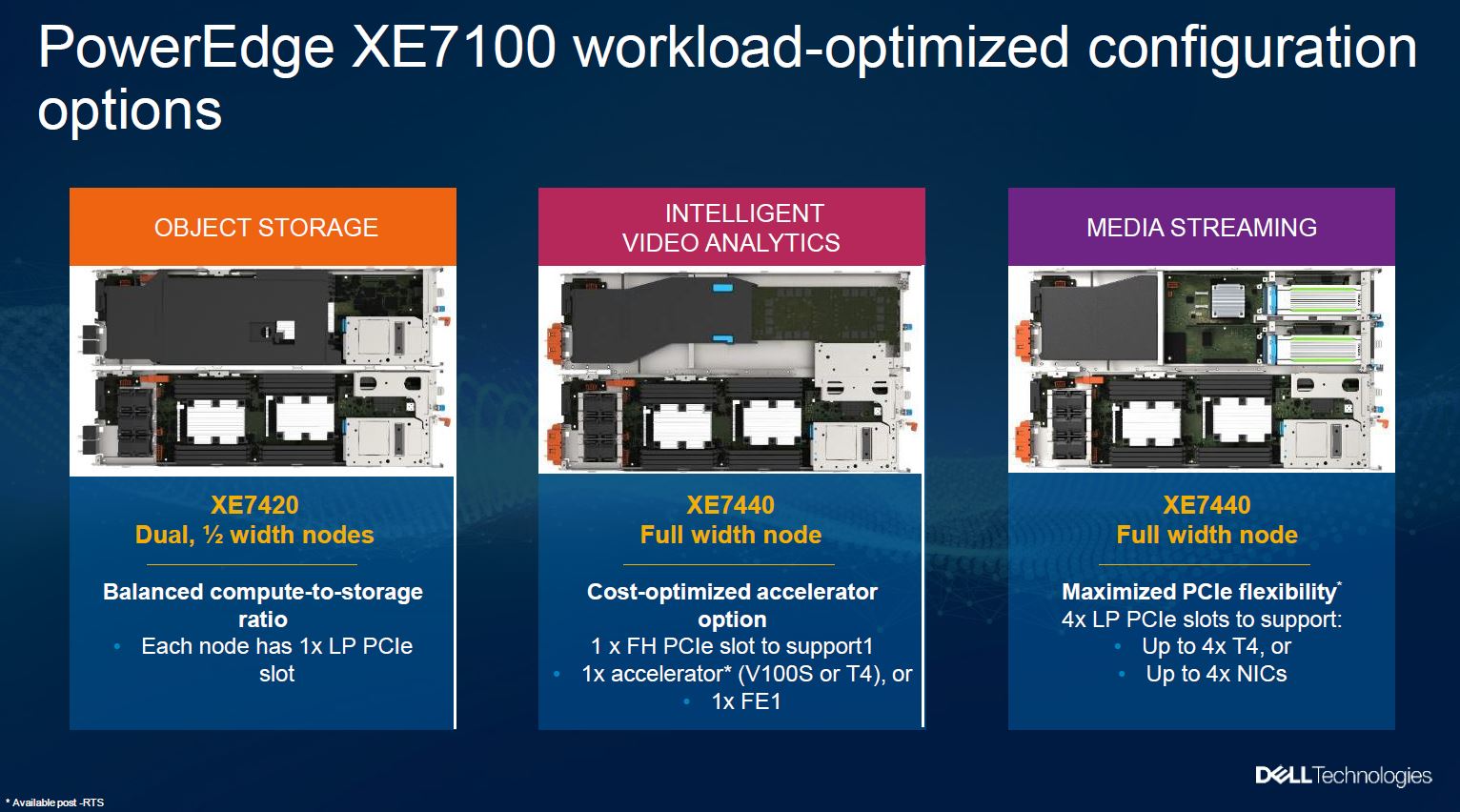
Another important aspect of top-loading storage servers is the weight. We asked Dell EMC about the weight of the servers and their racks. A standard Schneider Electric / APC NetShelter SX rack weighs around 295lbs and Dell says it has a 3000lb static load and a dynamic load of 2250lbs. A static load is where the rack is bolted into the data center floor and is in operation. Dynamic is when the system is on casters and being wheeled in a data center. Shipping loads are different given the stresses that can happen during transport that are not present in the data center.
A fully loaded PowerEdge XE7100 is around 300lbs. As one can quickly see, even 8x 5U 300lb systems are around 2400lbs. Dell told us we add the 295lb rack weight to these figures which would yield 5U of storage servers plus the rack at 2695lbs. That only leaves around 305lbs for switches, PDUs, cables, and cable management gear. The Dell Z9100-ON 100GbE switches we use in our lab weigh around 22lbs each without mounting hardware. Dell can fit, with a <10% margin, under the static load limits of a standard NetShelter SX. Still, Dell is pushing the racks within single-digit percentages of their loading limits. We specifically asked Dell about this since many high-density top-loading storage designs require specialized racks. For example, Apple which has been using over 100 drive/ 4U systems (>25 drives per U) utilizes specialized racks to handle this class of system to handle the loads. Dell told us that their standard racks are fine for the PowerEdge XE7100, but we want our readers to be aware that is only for static loading and with a small margin.
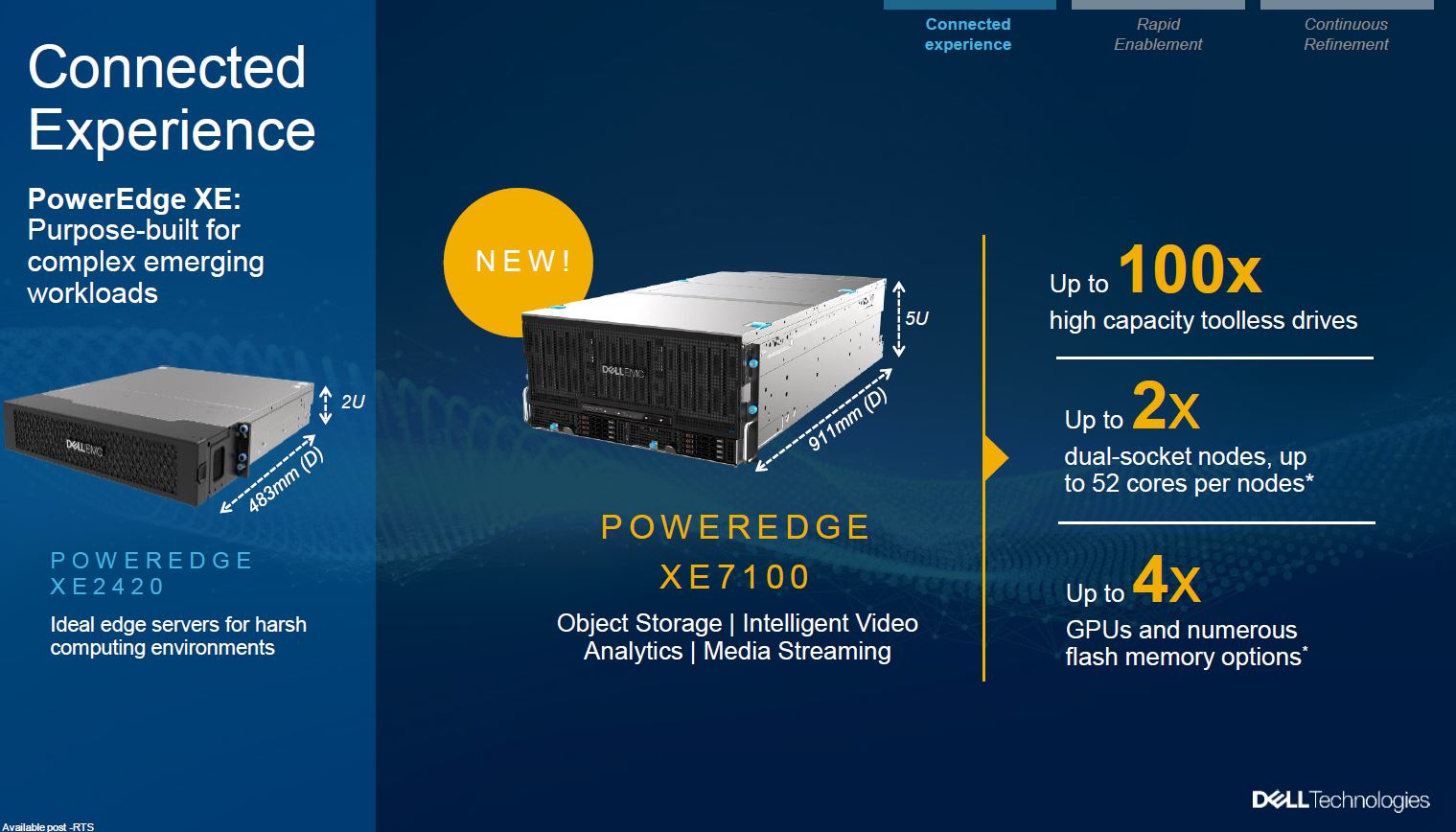
The Dell EMC PowerEdge XE7100 is part of the “XE” line. We previously covered the Dell EMC PowerEdge XE2420. Dell is using the XE designation for more experimental systems where it is exploring new spaces.
Overall, this is a great update to systems such as the DSS 7000.
Dell EMC OpenManage Update
As part of the announcement, Dell EMC is also discussing its OpenManage updates. Specifically, the company is discussing how it is bringing new plug-ins to OpenManage. An example of this is Update Manager. Dell is building a solution to a new level of autonomy in the data center. Update Manager helps manage tasks such as automatic firmware updates across a cluster to ensure no or minimal downtime in a cluster.
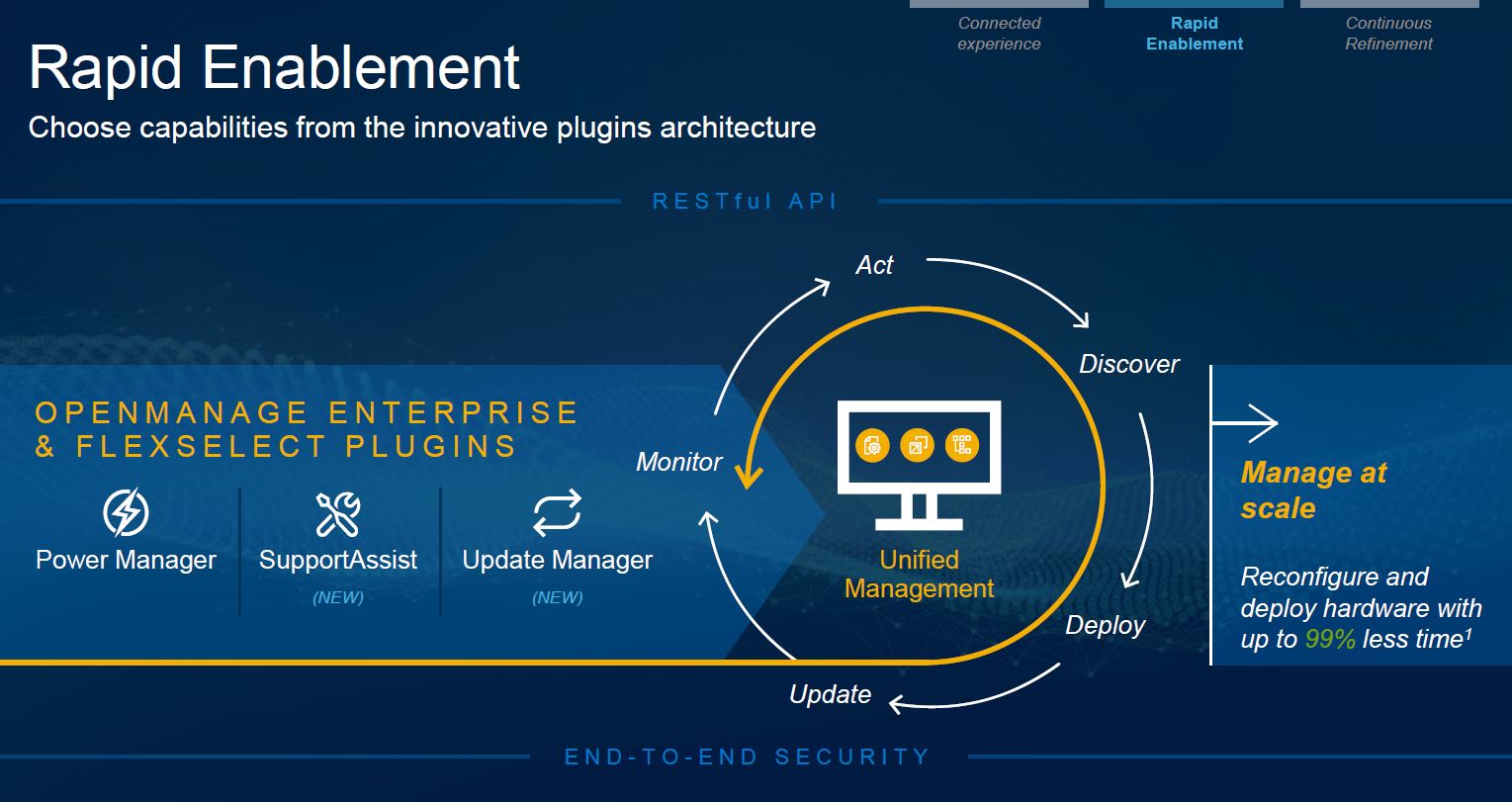
Part of the announcement also involves how Dell gathers data from its machines. Dell has solutions to allow data streaming of metrics to solutions such as Splunk analytics environments (Dell has platforms for this as well.) This helps companies use monitoring with higher fidelity and more intelligent tools to aid in troubleshooting and predictive analytics.
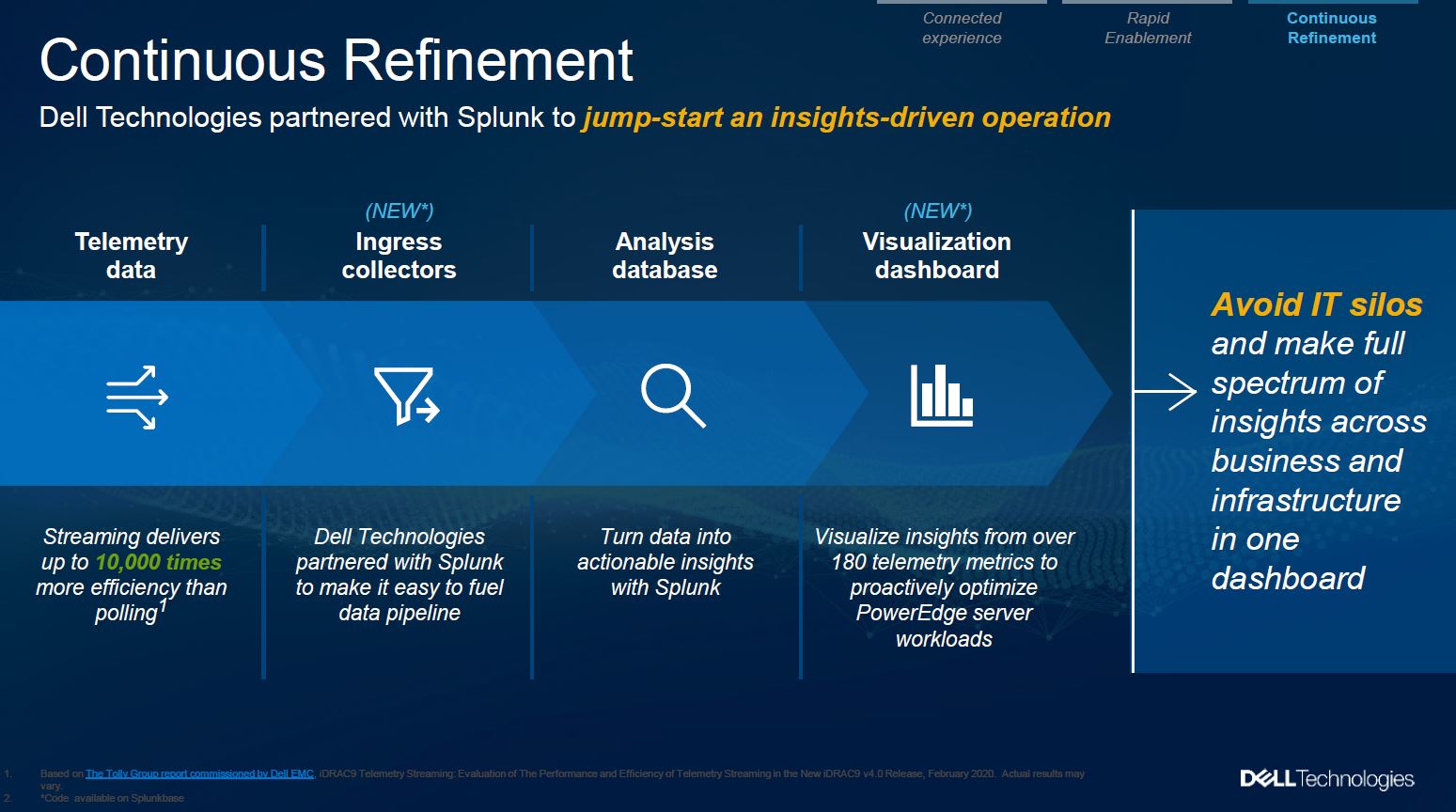
We asked Dell about how much data this can generate. Dell says that the raw JSON a server can generate if it is streaming the maximum amount of data is around 500MB/ day but 275MB/day is what Dell is estimating customers will see. That adds up if you have thousands of servers and want to retain the data. Dell says that in an efficient metrics database only needs to capture around 5MB of actual metrics once the JSON is stripped.
Final Words
Overall, it is great to see Dell EMC re-enter the top-loading storage server market. For companies that are locked into the Dell EMC ecosystem, the XE7100 provides a new solution for higher-density storage in Dell’s portfolio. For hard-drive-based storage, these large capacity storage servers are becoming popular as flash and persistent memory are claiming space in compute density focused servers.

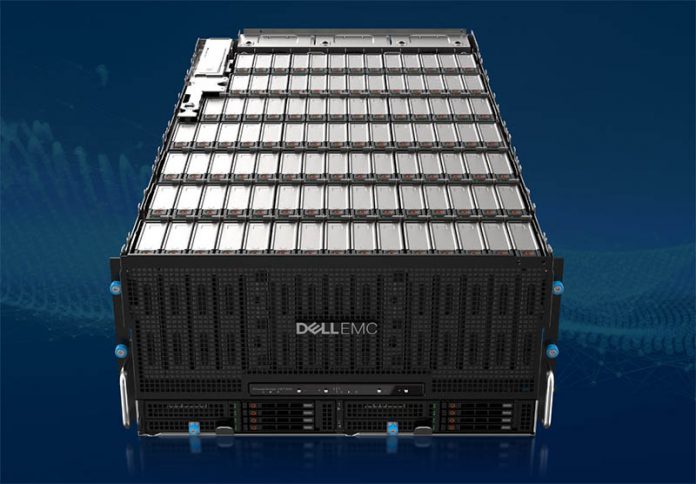



We’re still going to look at these as a “dell shop” when they refresh to EPYC or Ice. No point in buying Gen 3.0 PCIe in late 2020 since we want 100G networking on these servers and 100G 2P adapters are really inefficient in Gen 3.0.
Thanks for not being a Dell shill and at least being honest here.
Your rack weight section is gold. We’ll look at different racks when we transition to these.
52 cores per nodes mean they’ve got TDP restrictions since they can only take 26C not 28C Xeons. That’s insane since they’re using another U so they can get better airflow than their competitors.
90 in 5U should be making no claims on highest density today. I’m shocked Dell must be out of touch with the market
cringeworthy by dell marketing
good on sth for calling this out
Nice box. Ugly claim.
Seems silly to spend half the article talking about a marketing claim…
Having a 5U 911mm deep option is super helpful for those trying to fit these into normal size racks — we have seen huge issues dealing with ~1000mm chassis. Technically they fit, but they block most PSUs, and depending on the cabling you may not be able to close the doors. For someone stuck with a fixed footprint this is very helpful.
I’m with DanT on the greatness of being shorter 911mm. I’d disagree on the marketing claim discussion. The weight part is ultra-important. If STH doesn’t call out a claim like that, no other site will. I’d be worried if they didn’t.
I too, was initially turned off by the protracted pontifications of being against a silly marketing claim that ALL vendors and most OEM’s usually claim on a regular basis. I think a few lines refuting it would have sufficed. Instead, it came across as slightly silly and somewhat entitled.
Almost like there was a personal bone to pick with Dell…
In any case, this is a good thing, not bad. We need more vendors to start expanding on this. I dont forsee these being useful for the common guy, but this is what drives the industry, and hopefully allows slightly older gear to get cheaper and more readily available.
so stupid this is a storage server right which means storage is every thing dell’s could hold 1.6 pettabytes while this has 1.25 pettabytes ok so stop debunking while you are wrong shut up